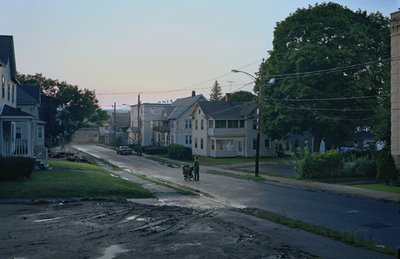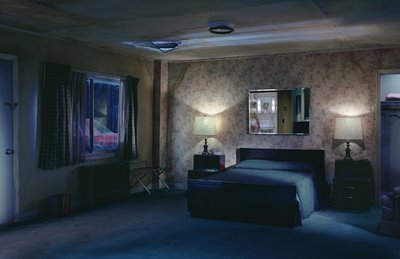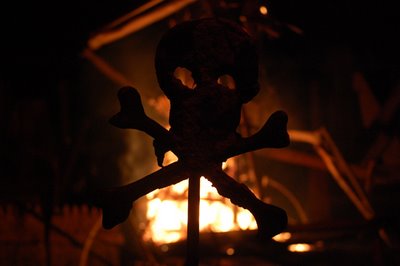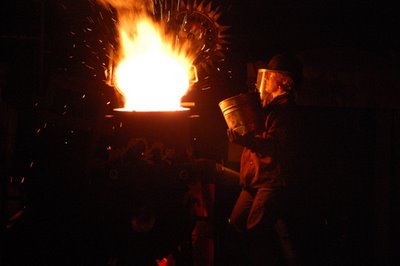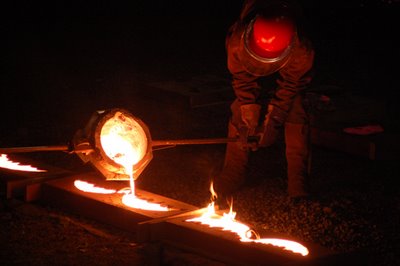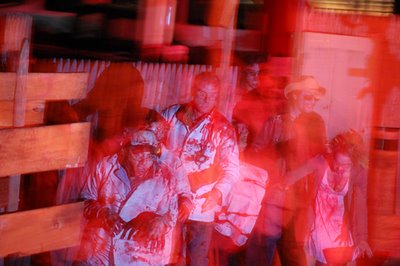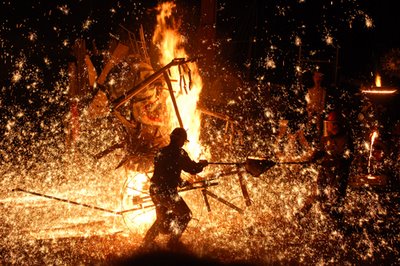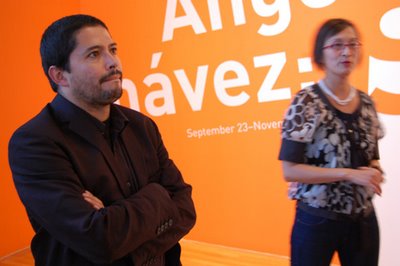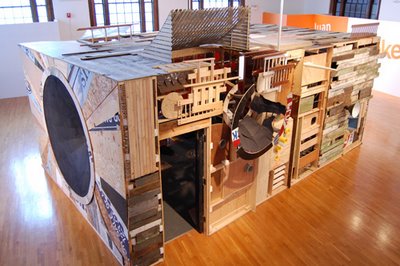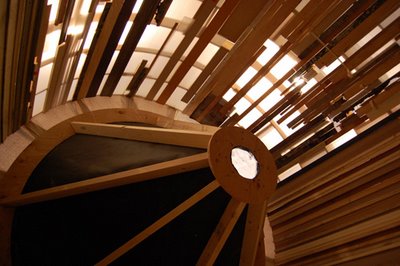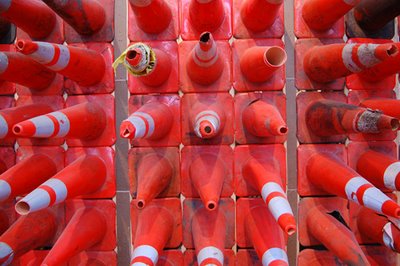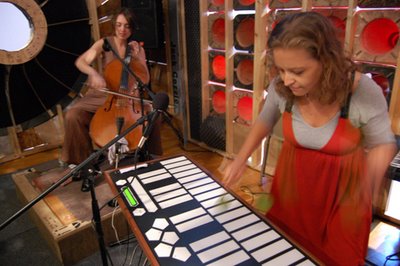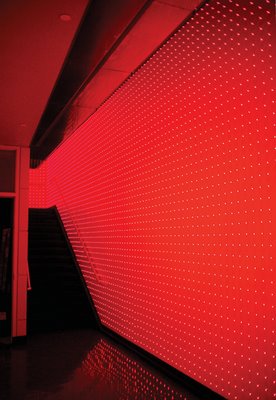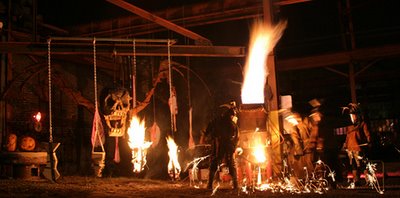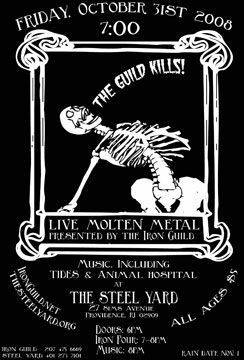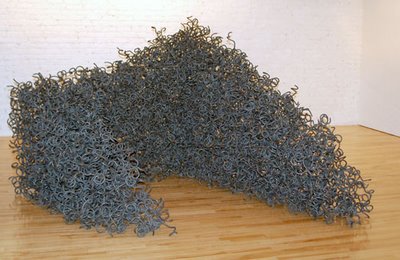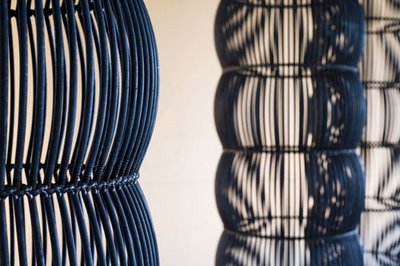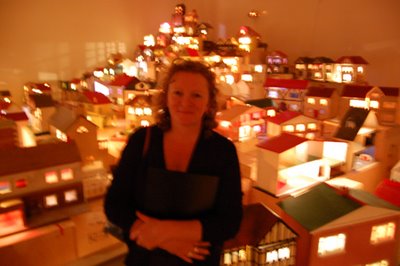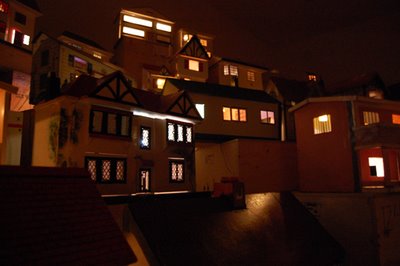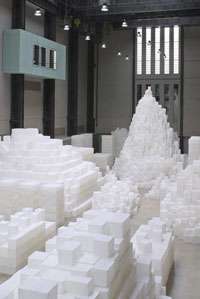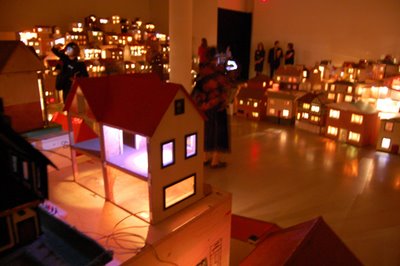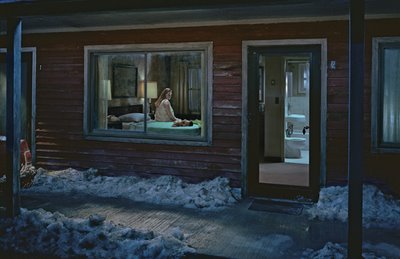 New York photographer Gregory Crewdson (below) spoke about his elaborately staged photographs at MassArt on Oct. 29, 2008.
New York photographer Gregory Crewdson (below) spoke about his elaborately staged photographs at MassArt on Oct. 29, 2008. 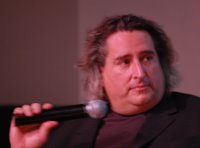 His “Beneath the Roses” series, which is pictured here, was shot outdoors in Pittsfield, Massachusetts, and on soundstages constructed at Mass MoCA in North Adams. Here are some excerpts of his talk:
His “Beneath the Roses” series, which is pictured here, was shot outdoors in Pittsfield, Massachusetts, and on soundstages constructed at Mass MoCA in North Adams. Here are some excerpts of his talk:“I’ve always believed that an artist has one central story to tell and the task over a lifetime – the almost impossible task – is to attempt to represent that story over and over again in pictoral form.”
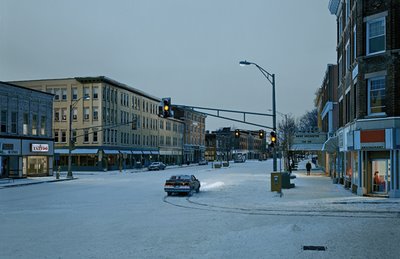
“I’m from New York City, but my parents had a country house outside of Lee, Massachusetts, which is not very far from here. And for a variety of reasons I began making pictures there. But I wasn’t interested in using photography purely to document this place. In other words, I wasn’t interested in that whole tradition of making a kind of objective portrait of a place through pictures. What I was more interested in was trying to create a language that hovered somewhere between reality and fiction. So I was interested in using this place, this setting, the inhabitants of this town as characters in my own narrative. I should also be clear that I was less interested in literal narrative than I was in trying to explore psychological dynamics through the use of light and color. Most everyone in these early photographs were strangers to me. I think that was really important. I always thought that there was this deep-seated connection between photography and voyeurism. Photography is an alibi. It allows you to explore your own fascination with things, and to explore forbidden secrets.”
“I can trace this kind of relationship to the world to the fact that my father was a psychoanalyst. And when I was growing up in Brooklyn, his office was in the basement of our house. So as a young child I have this early memory of attempting to listen to the floorboards and trying to decipher the goings-ons in the basement of the house. I wasn’t even quite sure what a psychologist was early on. Still not quite sure. I ask my therapist this every week. But I knew that in a certain sense the activity going on in the basement of our house was a secret, it was forbidden, it was mysterious. Later on I think I became aware that this was like an aesthetic awakening for me. And I think all of my pictures in one way or another play off this notion of an alien view of another world.”
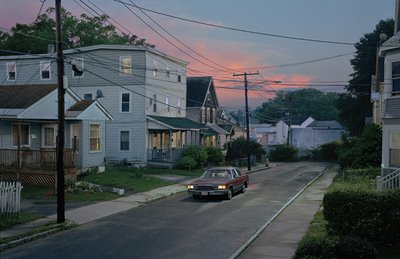
“The window also is a central metaphor that I continue to use over and over again. For me it’s a great device that suggests that separation, that distance between the subject matter. And it creates a kind of picture frame within a picture frame, and that way acknowledging the act of taking a picture.”
“The way I tend to make pictures is I have an image in my mind and then I try to actualize that image. And though that process the image dramatically changes.”
“Natural Wonder” series, 1992 to 1997: “When I was in graduate school [at Yale from 1986 to ‘88], I had I guess a paradigm shift in 1987 when I saw David Lynch’s ‘Blue Velvet,’ which forever altered my universe. And these pictures obviously demonstrate that. One thing an artist does is they create their own iconography, unconsciously. All artists are sort of drawn to create their own, I guess, language system or something. I’m drawn to certain motifs over and over again – windows, butterflies, piles, you know. … As these pictures progressed, even though they’re realist based, they became increasingly hallucinatory and dreamlike. And they became increasingly focused on death and decay. I was at the time very interested in the tension between beauty and repulsion.”
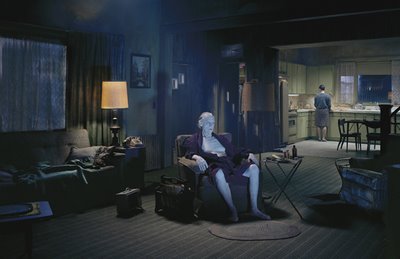
“Hover” series, 1996 to 1997, all shot from an elevated crane: “They’re the first pictures that I started having a kind of real interaction with community and started working on a larger scale. They’re done very sort of off the cuff. We had no permits. We just made the pictures. And I used just the people in the houses. So this is a photograph of woman who actually lived in one of the houses planting rows of flowers down the middle of her street. No one seemed to care, that was the other thing. No one even got out and walked out of their house.”
“This is literally looking down the same street from the opposite end. I made the decision to try to work in one area. One of my great sort of materials that I love so much is sod. And this is a man who is obsessively sodding his street closed, with his neighbors – I had to get them out of their house to pretend that they’re interested – sort of witnessing this kind of irrational event. For me it was a kind of optimistic picture about trying to make connections with your neighbors. As I was up there [in the crane] I realized that I wanted some tension that counteracted the optimism. So I shouted down to, I guess it was an assistant who was working with me then, and I said, ‘Call 911 and tell the police department that there’s a man sodding the street closed.’ And I literally saw the [police] car coming around. And then we sort of explained to him, and he was happy to participate.”

“I thought it would be nice to have a perfect circle of mulch in a backyard. So I location scouted and found what I saw as the perfect location. And I knocked on this door of the household, and no one was home. So I just wrote a note, and I said, ‘Dear homeowner, I’d like to build a perfect circle of mulch in your backyard and photograph it from an aerial perspective. Here’s my phone number.’ And then when I got back to the cabin, the next day, there was one blinking light [on the answering machine]. I’ve always said that I wish that I had saved this message because it’s really the greatest wisdom, the greatest advice that anyone could ever give an artist. All she said was, ‘Do what you have to do.’”
“Twilight” photos, 1998: “This is actually the first picture I made on a soundstage. I had had this image in my mind of a woman submerged in her living room, had it for years. And then when it became possible to work on a soundstage, I knew this was the first one I was going to attempt. We built a living room and then built a tank around it and flooded it. When I looked through the ground glass and I saw her expression, that was what the picture was truly about. It was terrifying.”
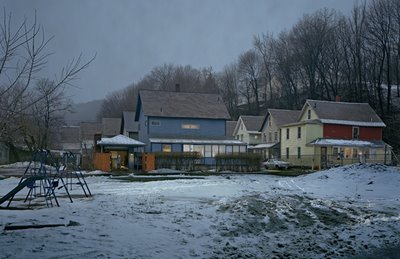 “Beneath the Roses”
“Beneath the Roses” series made over the last six years and completed spring 2008: “It’s funny, when you’re making pictures you’re not really – I’m not – conscious of really the motivations behind the photographs or what they mean, ever. It wasn’t until much later, I was producing the show, that I realized there’s a lot of cars with doors open. I thought, ‘Whoa, strange. I wonder what that means.’ And I actually have an answer for you, slightly. The pictures are really about in-between, about being in between one space and another space. So I like the idea of the car door suggesting that, a metaphor, neither here nor there.”
“There’s only a very small period of time where these pictures work, the [artificial] light works in concert with the ambient sun, which is magic hour essentially. A very small window. So like two or three days of setup and then this moment where everything comes together.”
“The pictures are very worked on in post-production. As you can see the camera never moves. The reason for that is although I shoot on 8x10 film, everything is scanned. I’ll shoot like 50 or 60 times, and then I’ll combine them in post-production to get absolute focus and saturation.”
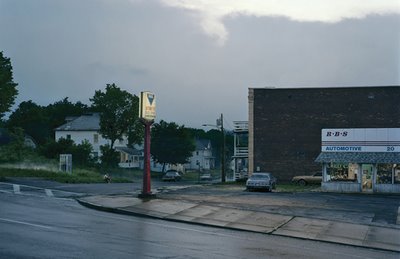
“The struggle always for me – or always whether you’re a film director or you’re working on that scale – is in the end it’s almost a contradiction, although you’re working with a very large group, in the end the picture, the final picture, must reflect your own particular view. And the picture often is very private and hard to define in terms of its meaning. Yes, it always changes, but in the end you have to feel like you own it, it has to feel like it reflects your own view of the world. And that more often than not happens. You can actually see it happening and it’s very strange. Often it looks very sort of nondescript, very ordinary, and then you can see as the light changes, it’s a very short period of time where the location is transformed into something that’s recognizably mine. That’s a very short moment. But it’s really for me the most important part of the process – I’m including post-production in that. Those moments, it’s when reality, everything sort of finds its own order and despite the chaos of closing down the streets and bringing this large equipment, those moments are very quiet and very still.”
“In this last group of pictures and other photographs, the figure becomes quite small in relation to the overall image. And that was a very conscious thing that I wanted to do. Because I wanted to deflate the pictures of literal narrative. And I wanted to be more about the sense of the place and more about isolation and loneliness. So the small figures suggest that sense of separation between the figure and the setting.”
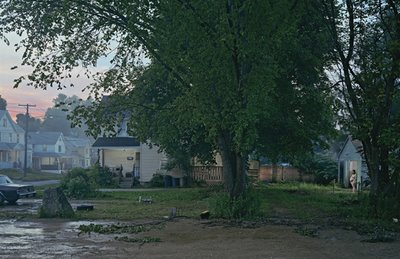
“I could never have imagined 20 years ago that this is how I would be making pictures. But through the slow evolution of the work it turns out that this is how I make pictures. And maybe strangely, it’s the only way I know how to make pictures now. I don’t even know how to make another kind of picture. So as I figure out what I’m going to do next that’s kind of scary to me, because as you can see I don’t even touch the camera, I’m an uncomfortable photographer. I don’t like touching cameras. I don’t even like holding cameras in my hands.”
“I like it emptied out. I like the subject to feel emptied out. I think it's partially because the whole question of narrative in photography is very different than it is in other narrative forms like film and literature. Photographs are an isolated moment frozen in time. There’s no before and there’s no after. So I want as little as possible from the actor because I don’t want to overly determine the meaning of the picture.”

“I do have different categories of protagonists. There is one I think central character category: a woman of a particular age who feels haunted by something. And then I’m also drawn to impotent men. And then there’s something about adolescence, that moment. I can’t really say why, only that I’m drawn to these types over and over again. But maybe one way of trying to approach the question of what the pictures are about is that there is obviously some kind of sadness in the photographs and there’s also a sense of beauty. So I really like when those two things intersect. And in that way I feel very indebted to [Edward] Hopper, that sort of intersection of sadness and beauty, and the wanting to make a connection in a world, a sense of possibility.”
Pictured: Gregory Crewdson, untitled 2006 and 2007 photos from the “Beneath the Roses” series, which were exhibited at New York’s Luhring Augustine gallery from April 4 to May 3, 2008. Courtesy of the artist and Luhring Augustine, New York.
